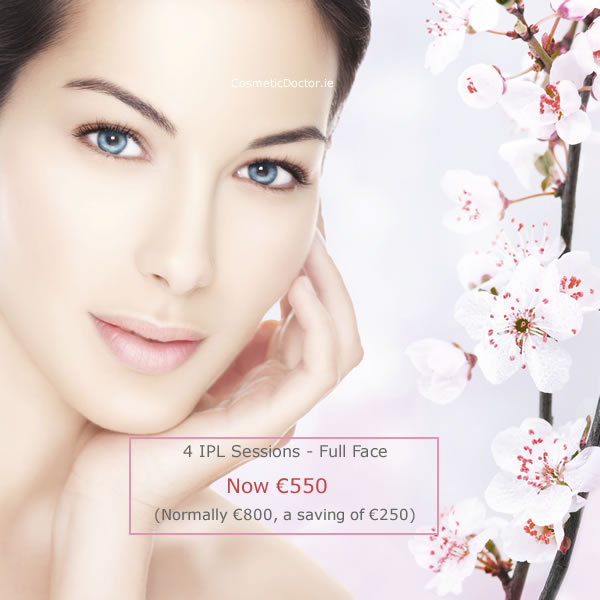Flawless for 2015 with IPL Photo Rejuvenation
It’s the ideal time of year to think about Intense Pulsed Light (IPL) Treatments to rejuvenate skin and eliminate pigmentation, as sun exposure is to be avoided after such treatments and the chances of getting any sun in our Irish winter is minimal.
IPL is a method used to improve damaged and ageing skin using high-intensity pulses of light. Often referred to as photo rejuvenation, it’s an effective way to correct and treat skin damage without disruption of the skin’s surface, and can be tailored to your individual condition and skin type.
IPL is used at Cosmetic Doctor to address a variety of skin issues, including:
- Broken veins, such as spider veins and thread veins.
- Vascular and pigmented lesions.
- Age spots, freckles, flat pigmented birthmarks and other skin discolouration problems such as melasma / chloasma and erythromelanosis of the neck (poikiloderma of Civatte).
- Rosacea.
- Facial lines and wrinkles.
IPL can also be used for mild to moderate acne and stretch marks.
How does IPL work to improve skin?
IPL is a non-ablative resurfacing system, which means it can target the lower layers of the skin (dermis) whilst leaving the surface (epidermis) unaffected. It works on a similar premise as laser in that the energy from the light is absorbed by the cells that contain certain pigments (melanocytes) in the skin.
That light energy is converted into heat energy when it hits the pigmented cells, and causes a controlled damage to the targeted cells, breaking down the pigment. IPL differs from laser in that it delivers many wavelengths (or colours) in each pulse of light, unlike laser which just deliver one specific wavelength.
The wavelengths of light penetrate deep into the skin tissue to stimulate the cells beneath the skin’s surface, and triggers the body’s response to eliminate injured tissues and dead skin cells, leaving fresh, younger-looking healthy skin.
The heat energy also stimulates new collagen production beneath the skin surface to firm and rejuvenate the skin, so after a series of treatments it looks brighten, smoother and more luminous.
Most IPL systems use filters to refine the energy output, which allows enhanced penetration of the skin without using too much energy, and so is considered a ‘lunchtime treatment’ as it has minimal downtime.
The procedure
Dr. Fay will discuss the process with each patient and review their expectations and concerns. The treatment itself is straightforward; the hand-held smooth glass surface of the IPL machine is applied directly to the skin to deliver precise pulses of light in each area being treated.
A topical anaesthetic may be applied, though Cosmetic Doctor use an IPL system with an integrated cooling system.
Protective eyewear is worn throughout the session, and most patients tolerate the treatment well. The sensation of the IPL pulses is usually likened to a light snap of a rubber band against the skin.
A course of treatments is recommended as IPL has a cumulative effect. Most patients can return to work immediately after the treatments, which take about 20 minutes.
Are there any side effects?
Some patients experience minor swelling or redness in the areas that were treated, which usually subside after a couple of hours. Patients will be advised that no sunbeds or fake tan should be used prior to IPL treatment.
Avoid hot showers or baths for 24 hours after treatment and you will be advised to wear a high SPF as skin will be extra-sensitive to light.
To find out more about what IPL treatments can do for your skin, please call 01 685 3100 for further details and special offers.

